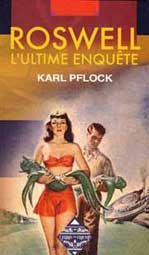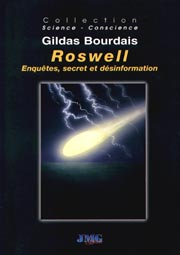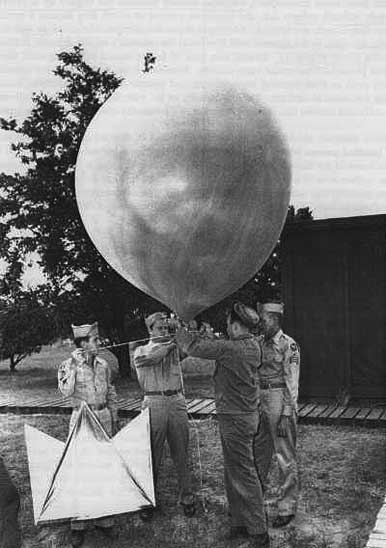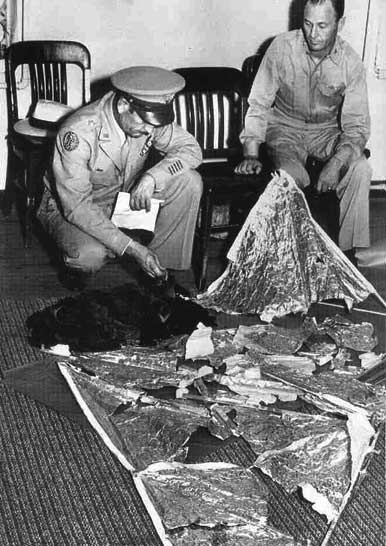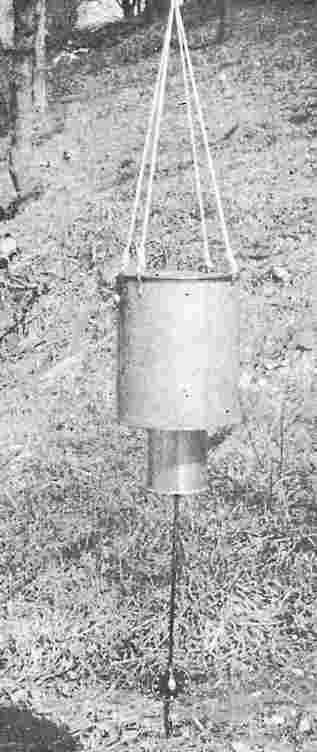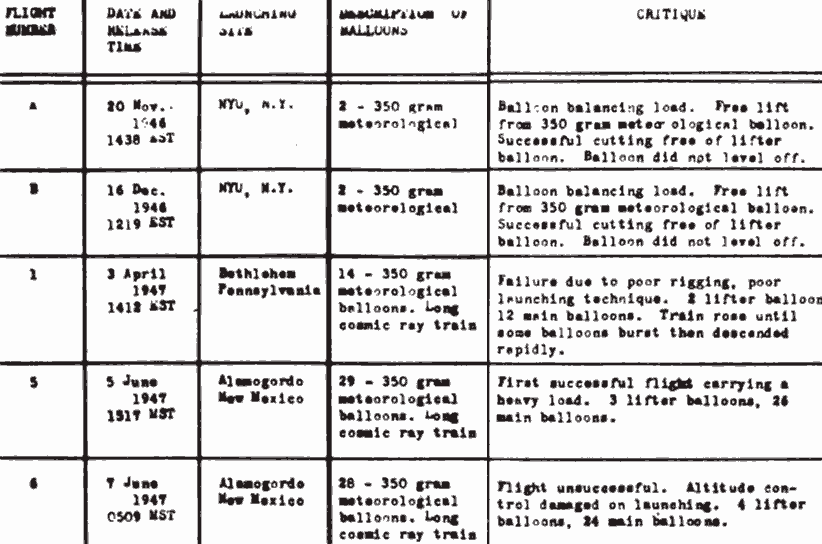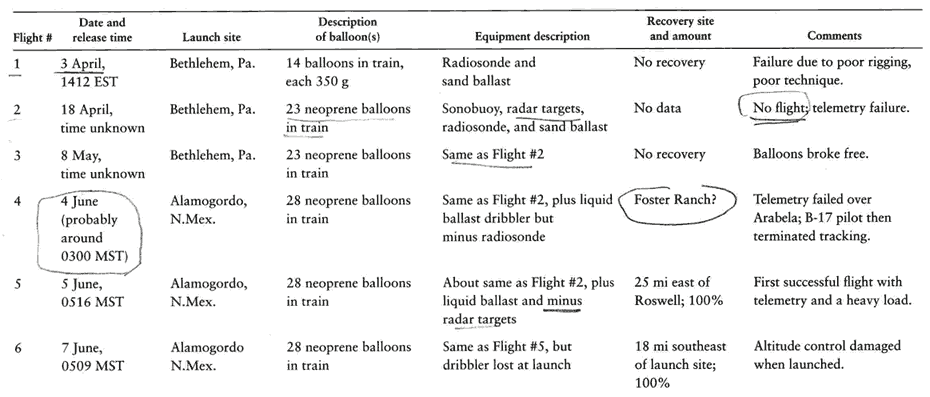Roswell, Mogul:
a critique of Karl Pflock’s book
By Gildas Bourdais, March 2007
Karl Pflock’s second book on Roswell, entitled Roswell: Inconvenient Facts and the Will to Believe, was published in the United States in 2001 (1). It has been translated into French and published in March 2007 with this radical title: Roswell: L’ultime enquête, meaning “the final inquiry”. As the author of my own book on Roswell in French (2), I am taking the liberty of giving my opinion of Pflock’s book and on the “Mogul” explanation it promotes.
The central thesis of Pflock’s book, which faithfully reflects the Pentagon’s “explanation,” is that the officers of the otherwise exceptionally competent and elite Roswell Army Air Base atomic bomber unit who announced their discovery of a “flying disk” on July 8, 1947, were completely mistaken.
Their announcement was made in the morning. By that evening, the Army had renounced it, explaining that they had merely found a small weather balloon and its radar target – a device comparable to a fragile kite, mounted on balsa wood sticks. And the press and public bought that story.
But the Roswell case resurfaced in the 1980’s, with a multitude of witnesses testifying to the secret retrieval of a crashed UFO. Public interest swelled, forcing the Air Force to conduct an investigation. The result was a “correction of trajectory,” in which the original weather balloon story was replaced. In 1995 the Air Force published a thousand-page book titled The Roswell Report, explaining the 1947 event by claiming it was “probably” a balloon train from Project Mogul. And it was implied that Mogul, which was designed to detect atomic bomb explosions in the Soviet Union, was at that time so secret that Roswell officers had to cover it up with the weather balloon story.
Cover of Karl Pflock’s book in French, with a nicely ridiculous science fiction illustration, and my own book on Roswell.
(These two books - in French - are for sale at our on-line bookshop: www.ovnilivres.com - credit cards accepted - GREPI)
The Pentagon’s Mogul thesis has been extensively criticized by several Roswell specialists who have exposed its many weaknesses. But a few researchers, most notably Pflock, continue to defend it, and it remains the explanation for Roswell accepted by mainstream media.
However, contrary to the peremptory title of the French version of Pflock’s book, the case is far from being closed. That book, although well documented (with almost all the “affidavits” of witnesses in an appendix), may convince those who don’t know the case well. I show, on the contrary, that the “Mogul” explanation is an imposture, and I will deal with other aspects of Pflock’s book that are no less questionable.
A not-so-impressive balloon train
Was the Mogul balloon train so strange and impressive that the officers in charge of atomic bombers could have mistaken it for a space ship? The Air Force has emphasized the imposing appearance of that 200-meter-high balloon array – two-thirds as high as the Eiffel Tower! And Pflock give us this description of the three arrays launched June 4, 5 and 7, all supposedly fitted with radar targets. “All three of the arrays were huge and complex, looming almost 700 feet from top to bottom in flight. Each employed twenty to thirty neoprene meteorological sounding balloons (the special polyethylene balloons were not yet available) and several payload, data transmitter, altitude-control, parachute, and disposable ballast packages.” (page 148). All that, he adds, was attached with particularly strong nylon line.
That description is misleading. First, it must be stressed that this balloon train contained no “mysterious” material, and that, in reality, there was nothing impressive at all, other than the great length. The neoprene rubber of the many small balloons would deteriorate in the sun in half a day (according to the technical test cited in the Roswell Report), and it was a “stop-gap method” (New York University Report N° 6), pending the delivery of the much better suited large polyethylene balloons. After a few days, there remained only darkened, smelly debris, such as that appearing in the pictures taken in the office of General Ramey at Fort Worth, when he presented it to the press.
Weather balloon with its radar target, and debris photographed in Fort Worth. One can see the blackened remains of a neoprene balloon at the feet of General Ramey (left) and his chief of staff, Colonel DuBose.
These little balloons weighed 350 grams, and the whole balloon train did not weigh much more than twenty kilograms. And what about those famous radar targets -- small kites weighing no more than 150 grams! Major Jesse Marcel, who had inspected the debris field with Captain Sheridan Cavitt, and other witnesses who had held in their hands debris found by ranch foreman Mack Brazel, described strange debris, especially little beams, very light but very strong. That’s where the radar targets, stretched on balsa wood sticks, enter the scene to play a key role in the Pflock-Air Force comedy.
According to the Pentagon, that’s what witnesses mistook for structural elements from a UFO! In order to get an idea of the value of that explanation, one only needs to buy a balsa wood stick at a hobby shop, 8 mm thick (the size of the radar target balsa members), and see how easy it is to break it with your fingers. As for the equipment hanging from the balloon trains, such as a ballast assembly and sonobuoy, they were just as ordinary in appearance. Not very impressive, that “aerial behemoth”, as Karl Pflock dares to call it in his book (p. 149).
Could the elite officers at Roswell have mistaken such materials for those of a “flying saucer,” and announced their discovery in a press release circulated worldwide? One need not be a proponent of a shameful “conspiracy theory” – denounced by sociologist Pierre Lagrange in his introduction to the Pflock book – to suppose that the officers were not so stupid! Once again, they were hand-picked officers, in charge of the world’s only atomic bomber unit at the time. Yet, this is, indeed, the explanation that many people still accept, probably frightened by the alternative – the discovery of a crashed craft of non-human origin – which appears to them even more improbable, perhaps unbearable. In effect, what is at stake in the Roswell affair is the prospect of an enormous historical and cultural shock for mankind.
In addition to the extreme weakness of the “Mogul” explanation, there are many other elements in favour of the theory of discovery of a craft of non-human origin. First, there is an impressive collection of concurring testimony about the finding of extraordinary materials. I have detailed them my book on Roswell (chapter 2). But let’s go directly to the heart of the intrigue: the famous balloon train Mogul 4, was the only one in the series launched in the appropriate time frame at White Sands which included the radar targets indispensable to give a semblance of consistency to the Mogul explanation. Unfortunately for Pflock, Lagrange and the Air Force, it was never launched!
Mogul 4 flight had been cancelled
It is necessary to explain the importance of Mogul 4 flight in the Mogul version. Those balloon train tests were carried out in an attempt to develop a system of detection at a high altitude of future Soviet nuclear explosions. The tests were made by a team from New York University (NYU) under military contract, first on the East coast, and later in New Mexico at White Sands, near Alamogordo, which had a more appropriate climate. One of the NYU team, the young physicist Charles Moore, had the idea of tracking the array flight routes with the radar system already in place for the tests of the V-2 rocket. All that was required was to attach a kite radar target at the bottom of the Mogul array.
The team had at their disposal a collection of kite targets, but they were fragile, and therefore reinforced by a New York toy manufacturer with adhesive tape which happened to be adorned with flower drawings. This was an all-important detail for the supporters of the Mogul theory because these stylised shapes of flowers (according the memory of Charles Moore) would serve to explain the strange markings – similar to hieroglyphs – noticed on the beam struts by Major Jesse Marcel!
But there was a little problem: as soon as the first successful launching at White Sands, which was Mogul Number 5, on June 5, they had already abandoned these radar targets because they were much too fragile, and preferred to rely on radiosondes for tracking. Mogul 4 was the only remaining flight from New Mexico planned to be equipped with those kite targets, all previous kite target tests having been made on the East coast.
And here is the heart of the Mogul imposture: balloon train number 4, which had been scheduled to be launched during the night of June 3 to 4, had been cancelled because of cloudy weather! It is not even mentioned in the detailed NYU reports, either in the report texts or in the complete table of flights (entirely reproduced in the big Air Force Roswell Report). On the other hand, that cancellation is noted in the personal diary of geophysicist Albert Crary, chief of the test flights (also reproduced in the Roswell Report). But then, how is it conceivable to still support the Mogul 4 scenario? With another trick by physicist Charles Moore, as we are now going to see.
Albert Crary notes in his diary that the next morning he had launched a simple little cluster of balloons, with a sonobuoy, of the kind that they launched everyday for training. Well, Charles Moore, in his book UFO Crash at Roswell, and the Air Force in its big Report, have decided that it was in fact the Mogul balloon train Number 4. In reality, nothing holds in that scenario. Charles Moore had to launch into complicated manipulations of wind directions and rates of climb (which have been exposed by the critiques) to make that hypothetic balloon train land precisely on the Brazel debris field, more than a hundred miles from White Sands. Even after fiddling with weather data, he still needed to have the balloon train take off at 3 a.m. during that night.
But Moore confesses in his book that he has no recollection of it, although he was directly involved in the project. That’s no surprise, the flight having been cancelled! He decides nevertheless that it must have been launched because it was found later on the Brazel ranch. But that’s precisely what he set out to demonstrate! So, he has modified the table of Mogul flights in the New York University report in order to incorporate in it his phantom balloon train Number 4. See the excerpts from the two tables at the end of this article. It’s just as simple as that!
The “flowered scotch tape” arguments
There is, however, an important objection made by the skeptics, including Karl Pflock, of course. The rancher Mack Brazel had probably found a little balloon cluster with radar targets on June 14, as he said in the evening of July 8, when he was interviewed in Roswell by the press, this time under military escort, thereby changing his first account. Now he described the famous balsa sticks with “flowered tape”! That is quite possible, since the White Sands team had been launching them every day in June for training. They were usually composed of three to five balloons and three radar targets. Brazel had probably found such a cluster, had picked it up, put in a bag and left it forgotten in his shed. It had nothing to do with his discovery of the strange debris field at the beginning of July, which had motivated his trip to Roswell.
Once again, without having a fit of conspiracy-theorist fever, we may suppose that the military in Roswell, who had held him at the base during the whole day on July 8, had told him to replace his finding of the beginning of July by the one of June 14. That explains why the two dates were quoted in the press: first the one at the beginning of July, in the morning press release, and then the date of June 14 at his press interview in the evening.
There are other reasons why the Mogul theory does not hold. For example, the voluminous 1,000-page Air Force Roswell Report says everything on balloons but has nothing, not the faintest hint, which would confirm the discovery of a Mogul balloon train on the Foster ranch. Besides, no Mogul instrument has ever been found there.
Even worse for Mogul theorists, the testimony of former Captain Sheridan Cavitt, the man who had inspected the debris field with Major Marcel on Monday, July 7, should have been decisive in favour of Mogul. But, during his long interview by Colonel Weaver in 1995, transcribed in its entirety in the Roswell Report, he stuck to the untenable denial of 1947 -- one weather balloon and its target -- and he denied having found a Mogul balloon train. This sworn testimony makes him, in fact, a negative witness against Mogul. And questioned about Karl Pflock, who had already become at that time an ardent promoter of Mogul, he had this ironic answer: “He’s our chief debunker. I lean toward him”.
For my part, I met with Pflock in 1995, at the MUFON symposium, and I pointed out to him that the description of the debris field by Marcel implied a violent explosion above the ground. After beating about the bush, he finally admitted it. But helium-filled balloons don’t explode. Anyway, two hours later, at the final debate, he stated with self-assurance that it was a Mogul balloon train. I saw then what kind of a man he was.
Other examples of trickery
It is impossible to detail in one single article all the falsifications and trickeries contained in Karl Pflock’s book, which is a sort of masterpiece of its kind. Anything goes to denigrate witnesses, one after each other. It is true that some of them are fragile, who have for instance changed their initial testimony (like Brazel, for one!). But there still remained very strong witnesses, who had to be put in doubt, imperatively.
This is the case, for instance, of General DuBose, at the time a Colonel and chief of staff of General Ramey (see the photo above), who is quoted by Pflock as saying that the real debris had been shown to the press. Actually, he said exactly the contrary in his sworn affidavit (it’s in the Appendix of the book and you only have to read it!). It is also the case with Major Jesse Marcel, accused of having lied about his military career. Kevin Randle, one of the best researchers on Roswell and a military officer himself, has completely refuted that argument, explaining that, just like Marcel, there are mistakes in his own military record, for example missing medals. On the other hand, the record of Marcel contains impressive praise from all his supervisors – both before and, much more significantly, after the Roswell Incident.
Do you want another example of falsification? Karl Pflock puts in doubt another important witness, Master Sergeant Lewis Rickett, assistant of Captain Sheridan Cavitt, who had taken him to a guarded field. There he had seen soldiers picking up debris, and he had noted its surprising properties -- very strong and very light at the same time. Pflock strives to cast doubt on Rickett’s testimony, devoting the whole of Chapter 10 to the exercise, using disputable arguments which are too involved to discuss here. But Pflock quotes him nevertheless (page 27) as saying that there was a small amount of debris, a detail which could support the discovery of a Mogul balloon train on the Foster ranch.
But it does not fit at all, because Rickett also says, in an interview with Mark Rodeghier, of CUFOS, that it took them only 45 minutes to go to the site, whereas it took at least three hours to reach the debris field on the Foster ranch. Of course, that “detail” is omitted by Karl Pflock. They had gone, in fact, to the other site, much closer to Roswell, where the UFO fuselage may have been retrieved (there is additional testimony about this second site).
Let’s quote still another argument, added by sociologist Pierre Lagrange in his introduction to the French edition. Playing with the idea that the whole Roswell affair could have been launched by disinformation services in order to hide real black programs, Lagrange suggests cleverly that the skeptics might suspect Kevin Randle, himself a former intelligence officer, of having participated in such a deception scheme. Even Karl Pflock had not dared to write that!
_______________________
Annex
1) Excerpt of the Table of Mogul flights, part of the complete report of New York University on Mogul flights, reproduced in the USAF Roswell Report of 1995.
